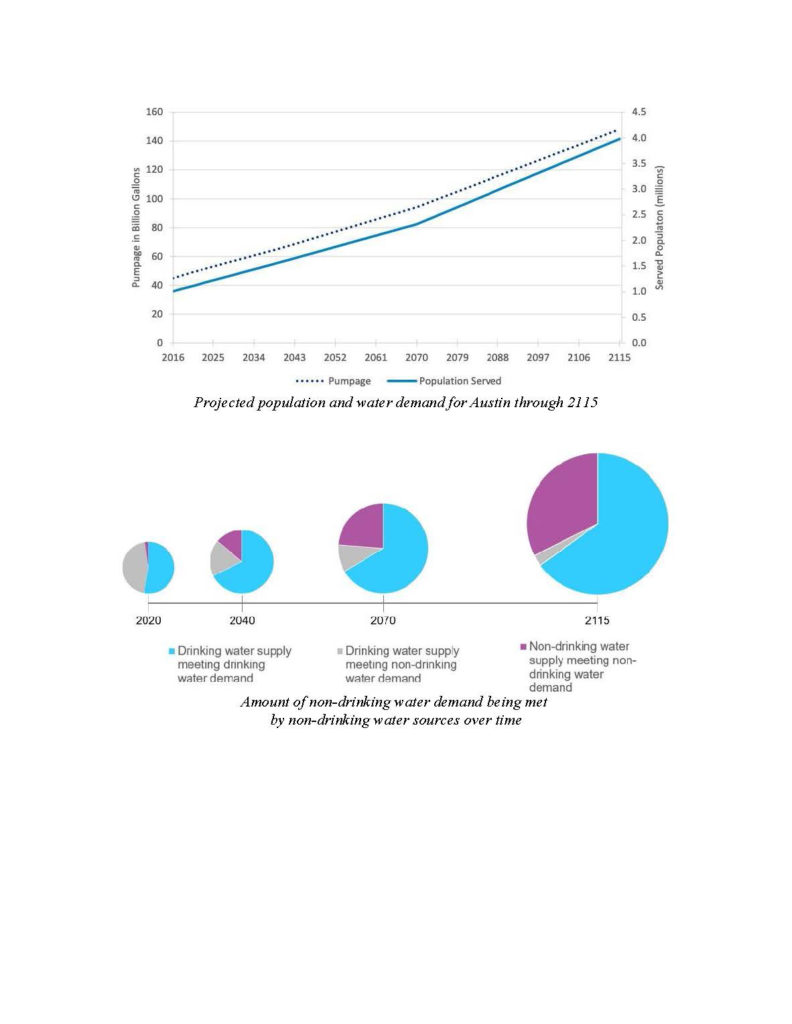With Four Million People and Climate Change, Where Will Austin’s Water Come From?
by Robert E. Mace
The drought of 2008 through 2016 was a wake-up call for Austin. As levels in the Highland Lakes—Austin’s sole source of water—dwindled to near-record lows, the city enacted drought restrictions that threatened landscapes and businesses. As lake levels continued to decline, Austinites worried that the city would run out of water. Fortunately, the rains returned; however, the ever-present threat of drought remains for our growing city.
In response to the drought, the city council formed the Water Forward Task Force to work with city staff and the community to develop a 100-year water plan for Austin. This planning effort focused on increasing the sustainability, reliability, and diversity of Austin’s water supplies with an emphasis on (1) water conservation and reuse; (2) projects that are technically, socially, and economically feasible; and (3) environmental protection. Unlike state planning efforts, which only extend 50 years into the future, Austin’s plan also considers the potential effects of climate change on our water resources.
The challenges to meet Austin’s future water needs are sobering. There are currently about 1 million Austinites. Demographers expect our population to grow to 2 million by 2065 and 4 million by 2115. On top of a rapidly increasing population are the anticipated effects of climate change—including increased temperatures and lower rainfall, both of which will result in less water flowing to our reservoirs. If Austin does nothing to shore up its water resources, the Highland Lakes may go completely dry for years at a time.
The good news is that Austin’s Water Forward Integrated Water Resource Plan identifies solutions to Austin’s growing water resource challenges. These solutions include both water efficiency and water-supply projects. Water efficiency includes installing smart water meters that will inform you when you have a leak, reducing leaks in the city’s water pipes, and requiring water-efficient landscaping in new construction. Eventually, new buildings will be required to use rainwater, stormwater, greywater (from sinks and showers), air conditioning condensate, and treated wastewater to meet non-potable needs.
Water-supply projects include storing excess river water in (1) an aquifer for use during a drought, something San Antonio has done with great success and (2) an off-channel reservoir (essentially a ring dike located away from the river).
In the coming months and years, you will hear more about these solutions as the city implements them. Similar to the development of the Water Forward plan, there will be opportunities for the community to voice opinions on implementation. With a changing climate, a growing community, evolving regulations, and developing technology, Austin will revisit and revise the plan every five years.
The Water Forward Integrated Water Resource Plan established Austin as a water leader in the state and the country. Working together, we can ensure that we meet our water needs while enhancing Austin’s quality of life and the protection of the environment.
To learn more about Austin Water Forward, please visit https://bit.ly/2JofNXK and https://austintexas.gov/aiwrpctf. To read the plan, please visit https:////bit.ly/304yaa7.
Robert Mace serves as a member of the Austin Water Forward Task Force as an appointee of Council Member Pool, District 7. Robert is also the Interim Executive Director and Chief Water Policy Officer at The Meadows Center for Water and the Environment at Texas State University.









